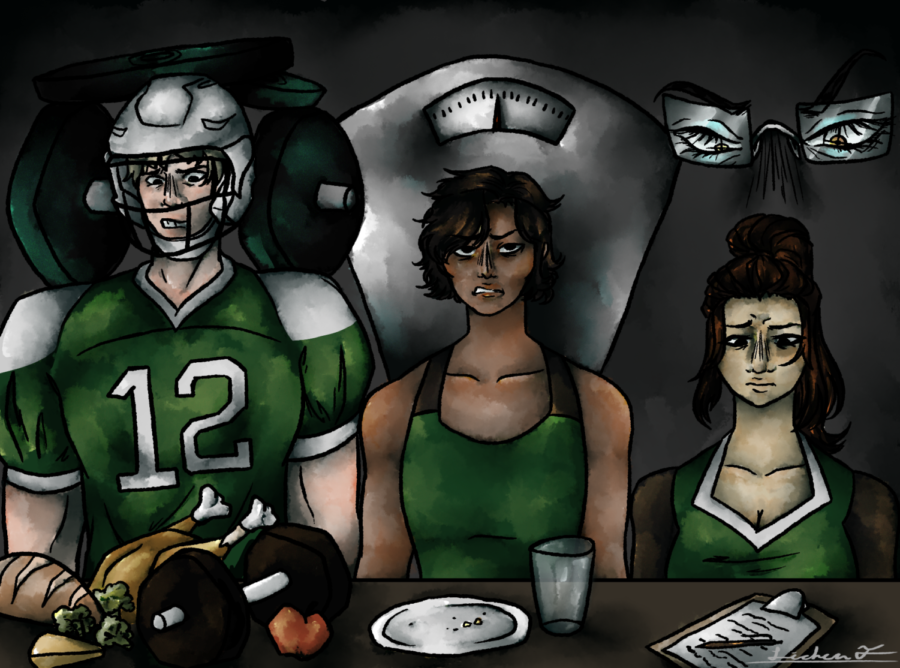Commentary: The aesthetics of athletics
While male college athletes are at a 10% risk of developing anorexia, and 38% for bulimia, female college athletes have a 35% risk of developing anorexia, and 58% for bulimia.
As the world continues to evolve, so does the pressure of having the right body type to be an athlete. This has led to a lot of issues with eating and exercise habits that could be very harmful to athletes all across the United States. While eating disorders have affected teens nationwide, athletes are two to three times more likely to develop an eating disorder.
Each sport creates pressure about different body types, so there are many reasons why the perfect body image for one sport can vary from another sport. According to a study of Division 1 athletes, over one-third of female athletes reported symptoms of anorexia. While eating disorders in male sports are not as common as they are in female sports, they still affect male athletes, but in a different, just as toxic way.
An example of this occurs in football, where in order to be competitive in any way, you have to lift weights and frequently be in the gym in order to have a successful team. Coaches push players extremely to reach their limits. A lot of times, football players, specifically offensive linemen and defensive tackles, have to eat an insane amount of food, because the more you weigh on the line, the harder it is to be bossed around on the field. According to Jordan Mazur, the coordinator of nutrition for the San Francisco 49ers, the range of calories needed for the team should consist of around 3,500 to 6,000 calories per day. While high school football players might not have to eat the amount of food that college or professional players need to, they still have to eat a lot of food, and it could be a lot more dangerous. High schoolers don’t have people monitoring them and helping them maintain their goals like the professional level does. This could lead to binge eating, which can have detrimental effects to an athlete’s health.
Pressuring athletes to lift and eat until they reach a breaking point is cruel, and we as a society need to know the limits of how athletes can handle the strain on their body and their mind.
While football provokes players to bulk up and eat a lot of food, wrestling almost does the opposite. In wrestling, you are put in a weight class to make sure you are going against someone of your caliber. Wrestlers typically want to be lean, with a good amount of strength, in order to be fit in a lower weight class and go against weaker opponents. A lot of times, wrestlers severely limit their food consumption and drink barely any water to get into the weight class they want. The lack of eating and desire for lean muscle can cause anorexia. Starving athletes till breaking point is terrible, especially when a weight class can make or break a wrestler’s performance.
Female athletes are where most of the eating disorders come from. While male college athletes are at a 10% risk of developing anorexia, and 38% for bulimia, female college athletes have a 35% risk of developing anorexia, and 58% for bulimia. This is due to the body image pressure focusing more on aesthetics and looks, due to a lot of sports like dance and cheerleading having competitions where the teams typically stress physical uniformity, which helps better the team score. This can lead to severe stress on teenagers and pressure to lose weight and not eat food, or even purge.
Bulimia is the most common eating disorder in cheer and dance, while anorexia is not far behind. Judges should not influence their score based on dancers’ looks rather than just the team’s performance.
How can this issue be fixed? While the need for a certain body type for a sport won’t go away anytime soon, our society can promote healthy habits, like mindful eating, not shaming people for eating food deemed unhealthy or having a structured eating schedule.















Mia Wiggen • Sep 30, 2022 at 10:49 am
I like reading about the different perspectives of athletes facing eating disorders. Especially since it isn’t really high lighted in main stream media
kylee • Sep 23, 2022 at 8:40 am
I didn’t understand that athletes went though this but I appreciate that this is bringing awareness
andrew • Sep 19, 2022 at 2:12 pm
good job pat shiesty